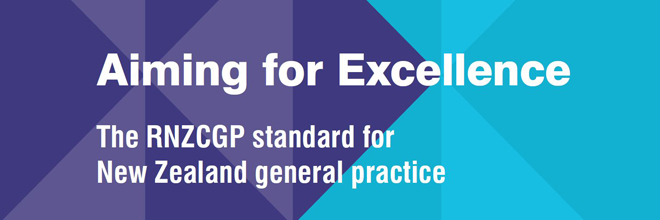
We are excited to announce that we will be launching the new Aiming for Excellence standard and its interpretation guide at our Quality Symposium in Auckland on 28 July.
Aiming for Excellence provides a recognised set of measurements for practices to demonstrate that their administrative and clinical structures and processes meet consistent, evidence-based criteria. This helps practices provide a safer, more effective, high quality service to patients.
Since it was last revised in 2011 Aiming for Excellence has continued to evolve in response to sector changes including:
- new legislation (Health and Safety at Work Act 2015 and Vulnerable Children Act 2014)
- processes that were once deemed aspirational have become more embedded in everyday practice (like using electronic clinical decision support tools)
- technological advances (such as eReferrals, ePrescriptions and patient portals).
These changes meant new criteria and updated guidance were required to help practices adjust to these new developments.
Take a sneak peek into the new standard
There are three levels of criteria in the revised Aiming for Excellence standard:
1. Foundation criteria
These criteria are the same as the Foundation Standard. They are mandatory, minimum quality assurance criteria and must be met by all practices. These include things like meeting the Health Information Privacy Code 1994 and having premises that are safe, accessible and comfortable.
2. Advanced criteria
This revision includes a number of advanced criteria. Some of these have been taken from the current version of Aiming for Excellence, but a number of new advanced criteria have also been developed (for example, using an electronic system to transfer patient records and medicines reconciliation). All foundation and advanced criteria must be met to achieve accreditation against the Aiming for Excellence standard (which is assessed by the CORNERSTONE® programme).
3. Aspirational criteria
This revision also includes a small number of aspirational criteria. Aspirational criteria allow advanced practices to extend their services and signal future development areas (for example, ePrescriptions and interdisciplinary electronic shared care plans). Attainment of these aspirational criteria is voluntary.
There is also a new section in the revised standard for specialised services provided by some general practices. In this version we have one new indicator in this section – one for patient portals. The indicators in this new section are not required by all practices, only those providing these facilities.
How the new standard was developed
The current 2011-2014 Aiming for Excellence standard was reviewed by an expert team of sector representatives and the updated standard was approved by the College Board in April 2015. Since then the College’s Quality team, in consultation with sector stakeholders, has revised and updated the current interpretation guide, and developed guidance for the new indicators and criteria.
We are thrilled this large project is nearing completion and wish to thank all of those in primary care who supported the process. This includes people like PHO quality managers, current assessors and organisations such as the Ministry of Health, WorkSafe New Zealand and the New Zealand Fire Service, as well as people on the ground like GPs, practice managers and nurses, and community pharmacists who have also lent their wisdom.
So what’s next?
The guide will be published on our website in August. Once the new standard is launched we will work out, in consultation with PHOs and practices, the process for moving CORNERSTONE ® practices onto the new standard. Practices will not have to move immediately.
We will keep you informed about progress and look forward to sharing this new standard with you soon.